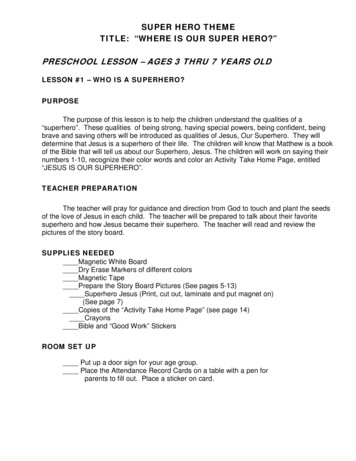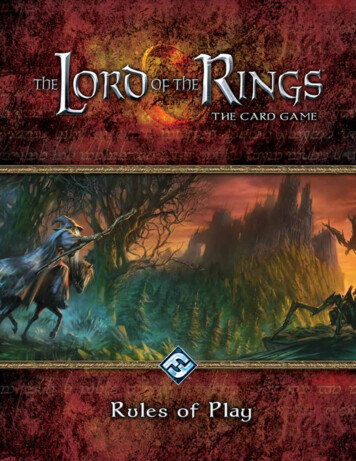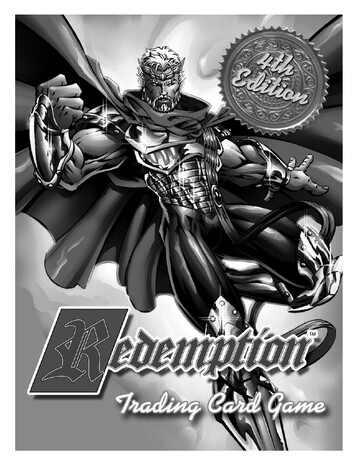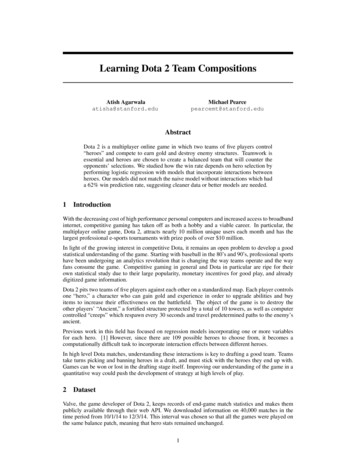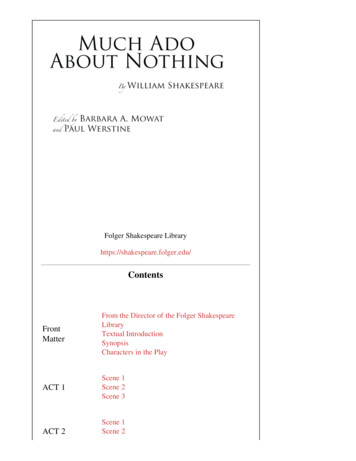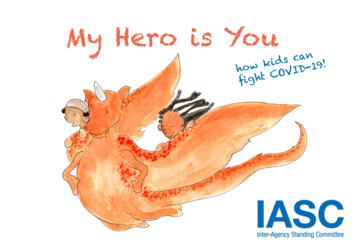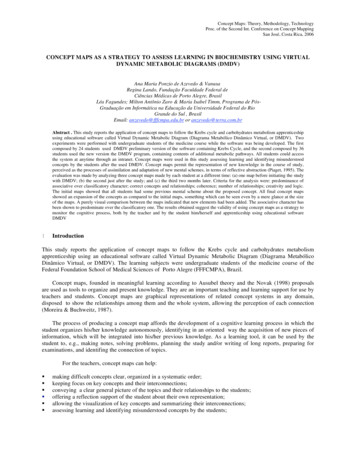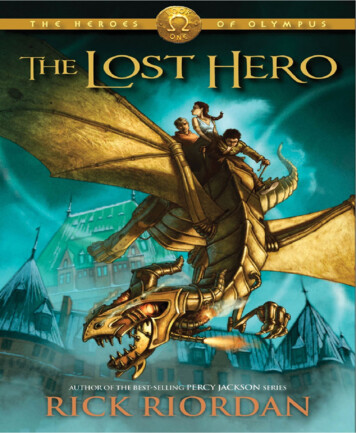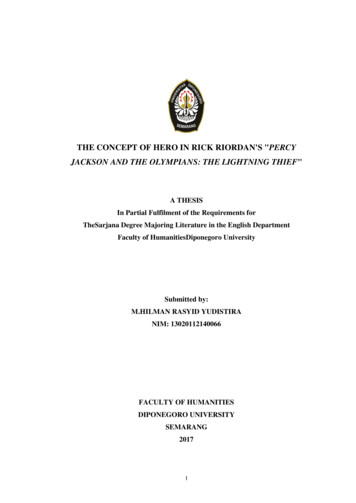
Transcription
THE CONCEPT OF HERO IN RICK RIORDAN'S "PERCYJACKSON AND THE OLYMPIANS: THE LIGHTNING THIEF"A THESISIn Partial Fulfilment of the Requirements forTheSarjana Degree Majoring Literature in the English DepartmentFaculty of HumanitiesDiponegoro UniversitySubmitted by:M.HILMAN RASYID YUDISTIRANIM: 13020112140066FACULTY OF HUMANITIESDIPONEGORO UNIVERSITYSEMARANG2017I
PRONOUNCEMENTThe writer honestly confirms that he compiles this thesis by himselfwithout taking any results from other researchers in S-1, S-2, S-3, and in diplomadegree of any university. The writer ascertains that he does not quote any materialfrom other publications or someone’s paper except from the reference mentioned.Semarang, 27th of September 2017M.Hilman Rasyid YudistiraII
MOTTO AND DEDICATIONEveryone in this world is a guest, and the money is a loan. The guest will surelyleave, sooner or later, and the loan must be returned.IbnMas'udYour time is limited. Do not waste it by living someone else's life.Steve JobsThis thesis is dedicated tomy beloved family and to everyonewho help and give me an endless love and support to accomplish this thesis.III
THE CONCEPT OF HERO IN RICK RIORDAN'S "PERCYJACKSON AND THE OLYMPIANS: THE LIGHTNING THIEF"Written by:M.HilmanRasyidYudistiraNIM: 13020112140066is approved by thesis advisor,on 28th August, 2017Thesis Advisor,Dr. I. Maria Hendrarti, M.A.NIP. 19530728 198012 2 001The Head of the English Department,Dr.AgusSubiyanto, M.A.NIP. 19640814 199001 1 001IV
VALIDATIONApproved byStrata 1 Thesis Examination CommitteeFaculty of Humanities Diponegoro UniversityOn September27th, 2017Chair PersonFirst MemberDr.RatnaAsmarani, M.Ed., M.Hum.Drs.SiswoHarsono, M.Hum.NIP. 19610226 198703 2 001NIP. 19640418 199001 1 001Second MemberThird MemberHadiyanto, S.S., M.Hum.Dra.Wiwiek Sundari, M.Hum.NIP. 197407252008011013NIP. 195906071990032001V
ACKNOWLEDGMENTSThe writer’s deepest gratitude goes to Allah SWT who has given strengthand faith so that this thesis entitled Concept of Hero in Percy Jackson and TheOlympians: The Lightning Thief came to a completion. On this occasion, thewriter would like to thank all those people who have helped and contributed to thecompletion of this thesis.The writer’s deepest gratitude and appreciation are extended to Dr. I.Maria Hendrarti, M.A, as his academic advisor who gave him continuousguidance, helpful correction, moral support, advice, and suggestion, withoutwhich it was doubtful that this thesis came into completion. The writer’s deepestgratitude also goes to the following;1.Dr.Redyanto M. Noor, M.Hum., as the Dean of Faculty of Humanities,Diponegoro University.2.Dr.Agus Subiyanto, M.A., as the Head of English Department, Faculty ofHumanities, Diponegoro University.3.All lecturers of the English Department Diponegoro University. The writerthanks them for the valuable knowledge, guidance, and help during hisstudy at the university.4.Special thanks to the writer’s beloved parents, Gatot Suyatno and IrzaMurni, who always give an endless prayers and supports for his educationboth financially and morally.VI
5.JKL – 05 Family, Dianika Bhayangkara W., Ulinnuha Al Haris, RifqiAdzani, Risky Hendra Setiawan. Thanks for your supports, sharing andcaring each other in the old blue house.6.To CHUDI, Cindy, Ulin, Diah, and Indah. Thanks for the motivation andour precious time we’ve spent together.7.All fellow friends in the English Department 2012 especially class B andliterature, the writer thanks them for giving amazing days during her studyat the university.8.The writer's best classmates in the English Department 2012, especiallyfor Sasing Futsal ‘12.9.The writer expresses gratitude for all related people who always supportthe writer to complete this thesis.The writer realizes that this thesis is still far from perfection. Therefore, hewill be glad to receive any constructive criticism and recommendation to makethis thesis better. Finally, the writer expects that this thesis will be useful to thereader who wishes to learn something about the concept of hero.Semarang, 28th August 2017M.Hilman Rasyid YudistiraVII
TABLE OF CONTENTSTITLE . iPRONOUNCEMENT . iiMOTTO AND DEDICATION . iiiAPPROVAL . ivVALIDATION .vACKNOWLEDGEMENT . viTABLE OF CONTENTS . viiiABSTRACT . xiiCHAPTER IINTRODUCTION .11.1 Background of the Study .11.2 Research Problems .21.3 Purposes of the Study .21.4 Methodology .21.5 Short Glance of Theoretical framework .31.6 Organization of the Thesis .4CHAPTER IIBIOGRAPHY OF RICK RIORDAN AND SYNOPSISOF PERCY JACKSON AND THE OLYMPIANS: THELIGHTNING THIEF . 62.1 Biography of Rick Riordan .62.2 Synopsis of Percy Jackson and The Olympians: TheLightning Thief .7CHAPTER IIITHEORETICAL FRAMEWORK . .10VIII
3.1 Intrinsic Elements .103.1.1 Character .113.1.2 Conflict .113.1.3 The Structure of Narratology .123.1.4 Vladimir Propp's Narratology .14CHAPTER IVDISCUSSION .234.1 Analysis of Intrinsic Aspect .234.1.1 Analysis of Characters .234.1.1.1 Percy Jackson .244.1.2 Analysis of Conflict .244.1.2.1 Internal Conflict .244.1.2.2External Conflict .254.2Analysis of Vladimir Propp's function .274.2.1The First Sphere: Introduction .294.2.1.1 Absentation .304.2.1.2 Interdiction. . .314.2.1.3 Violation .324.2.1.4 Reconnaissance . .334.2.1.5 Delivery .344.2.1.6 Trickery.354.2.1.7Complicity . 374.2.2 The Second Sphere: Body of The Story .384.2.2.1 Villainy and Luck .38IX
4.2.2.2 Mediation .394.2.2.3 Counter action.414.2.2.4 Departure .424.2.3 The Third Sphere: The Donor Sequence .424.2.3.1 The first function of the donor .434.2.3.2 Hero's reaction .434.2.3.3 Provision .444.2.3.4 Guidance .444.2.3.5 Struggle .454.2.3.6 Branding .464.2.3.7 Victory .474.2.3.8 Liquidation.484.2.4 The Fourth Sphere: The hero's return .494.2.4.1 Return .494.2.5 Identifying the characters .494.2.5.1 The Villlain: Kronos .504.2.5.2 The Donor: Chiron.514.2.5.3 The Helper: Annabeth Chase and Grover Underwood. 524.2.5.4 The Princess and Her Father: Sally Jackson andPoseidon .534.2.5.5 The Dispatcher: Chiron .544.2.5.6 The False Hero: Ares and Luke .55X
4.2.5.7 The Hero: Percy Jackson .554.2.6 Reasons the main character can be called Hero.574.2.7 The scheme of relationship between the hero and otherroles .594.2.7.1 The Hero and The Villain .594.2.7.2 The Hero and The Donor .594.2.7.3 The Hero and The Helper .604.2.7.4 The Hero and The Princess with Her father .604.2.7.5 The Hero and The Dispatcher .614.2.7.6 The Hero and The false Hero.614.2.7.7 The Hero and The Repentant Villain .62CHAPTER VCONCLUSION .63BIBLIOGRAPHY .65XI
ABSTRACTThe purpose of writing this thesis is to analyze the concept of hero inPercy Jackson and The Olympians: The Lightning Thief. The thesis iscompleted by using Vladimir Propp's Naratology. The analysis will befocused on the concept of hero of the main character, Percy Jackson. Inorder to analyze and collect the data, the writer uses library research andinternet. After conducting the analysis, the result shows some points.First, the writer found out that there were some functions that had to becompleted by a hero. Second, from those functions, the writer couldexplain the roles of action of the characters in the novel. Finally, the typeof hero could be identified which could describe the concept of hero inthe novel.Keywords: Hero, Seeker-hero, functions, Naratology, Vladimir ProppABSTRAKTujuan penulisan skripsi ini adalah untuk menganalisa konsep pahlawanyang ada dalam Percy Jackson and The Olympians: The LightningThief. Penelitian ini diselesaikan dengan menggunakan Narratologi dariVladimir Propp.Pembahasan ini akan diutamakan pada konseppahlawan dari karakter utama, yaitu Percy Jackson.Untuk menganalisisdata yang ada, penulis menggunakan metode studi pustaka dan risetinternet.Setelah melakukan analisis, penulis menemukan beberapahasil.Yang pertama, penulis menemukan bahwa ada beberapa fungsiatau tahapan- tahapan yang harus diselesaikan seorang pahlawan.Kedua,dari fungsi- fungsi tersebut, penulis dapat menjelaskan peranperan dari karakter di dalam novel. Yang terakhir, jenis pahlawan dapatdiidentifikasi yang akan menjelaskan konseppahlawan di dalam novel.Kata kunci: Pahlawan, pahlawanpencari, fungsi- fungsi, Naratologi,Vladimir Propp.XII
CHAPTER IINTRODUCTIONThis chapter contains some aspects to introduce, explain, and analyze thenovel. Those aspects are, background of the study, research problems, purposes ofthe study, methodology, short glance of theoretical framework and organization ofthe thesis. These aspects will be explained in the following paragraphs.1.1BACKGROUND OF THE STUDYReading and understanding a novel may give us all happiness and pleasurewhen we enjoyed it. It also contains of many histories of popular people in thepast and how those people could get their success or even failed in the past whichwe can learn through their experiences. Reading novel can be something to helpus to escape from the reality into a fictional world which can satisfy our soul.In Percy Jackson and the Olympians: The Lightning Thief, there are somany aspects that can be analyzed, but the writer only focuses his analysis on theconcept of hero that can be found in this novel. The writer hopes this paper canhelp the readers to understand about how to analyze the signs of hero which canbe found from the character of Percy in "Percy Jackson and The Olympians: TheLightning Thief".Rick Riordan's Percy Jackson and The Olympians: The Lightning Thieftells about a 12 years old boy who suffered from dyslexia and hyperactive. At thattime, there is a dispute between Zeus and Poseidon who accuses Percy of stealinghis lightning. He is then mixed up in an adventure in order to return the lighting
2and to save his mother as well. This novel is actually aimed to children, so that thewriter can give wide-imagination about the adventure of Percy Jackson in afantasy world. It also can be easily understand by children. There are also manymoral values that can be taken from this novel which gives the representation howthe hero must be. The hero must pass certain stages in order to complete his quest.Based on the reason above, the writer is interested to do an analysis on this novel.1.2RESEARCH QUESTIONSThe problems which are intended to be analyzed in this research are:1.What are the stages or functions that must be completed by a hero?2.What are the roles of action that can be identified in Percy Jackson andThe Olympians: The Lightning Thief ?1.3PURPOSES OF THE STUDYThe purposes of the study are:1.To describe the roles of action in Percy Jackson and The Olympians: TheLightning Thief.2.To analyze the type of hero of the main character.1.4METHODOLOGYIn this section the writer uses the library research methods in analyzingRick Riordan's Percy Jackson and the Olympians: The Lightning Thief. By using
3library research methods, a variety of important and reliable information can beobtained and used as a reference. In conducting his research, the writer does notonly get the sources used in this study from the books, but also from anothersources, for example the Internet. Through the internet, the writer can get varioussources, such as electronic books, journals, and etc.Actually, the writer only uses one approach in this thesis. It is intrinsicapproach. In intrinsic aspects, the writer analyzes character and conflict of thestory, and also the Structure of Narratology from Vladimir Propp.1.5SHORT GLANCE OF THEORITICAL FRAMEWORKThe thesis is completed by using Vladimir Propp's Narratology. Propp saidthat the character must complete some stages or function so he can be called ahero (1968: 80). There were 31 functions that Vladimir Propp mentioned.However, in analyzing this thesis, the writer did not apply some of thosefunctions. It was related to the case that not all of the functions could be found ordescribed in this novel. Therefore, only 20 functions which had been applied bythe writer in this thesis. Then, those 20 functions were also divided into 4 groupsof sphere. Those are: introduction, the body of the story, the donor sequence andthe hero's return.1.6ORGANIZATION OF THE THESIS
4The writer arranges this thesis into five chapters as follows in order to make asystematic writing:CHAPTER IINTRODUCTIONIt shows the background of the study, researchquestion, purposes of the study, methodology, shortglance of theoretical framework and writingorganization.CHAPTER IIBIOGRAPHYOFTHEWRITERANDSYNOPSISIt describes a biography of the author of PercyJackson and The Olympians: The Lightning Thiefand a synopsis of the novel. The synopsis purposeson giving the correlation between the story of thenovel and the content written in this study.CHAPTER IIITHEORITICAL FRAMEWORKIt contains literary review which gives explanationabout all of the theories used in the thesis. Thetheories included in this study give the definitionsand explanations of intrinsic elements. The intrinsicelements include character, conflict, and also theStructure of Narratology from Vladimir Propp.
5CHAPTER IVANALYSISIt contains the discussion of the thesis which willanalyze all of the theories’ application on the novel.It includes the analysis of the Vladimir Propp'sstages or functions which must be passed andovercome by a hero in order to complete hismission.CHAPTER VCONCLUSIONIt contains the conclusion of the discussion which isdescribed in the previous chapter.BIBLIOGRAPHY
CHAPTER IIBIOGRAPHY AND SUMMARY2.1 BIOGRAPHY OF RICK RIORDANThe information about Rick Riordan was taken from three sources thoseare famouswriters.net; primaryfacts.com; and rickriordan.com. All of thosesources were accessed on January 10, 2017.Richard Russel Riordan Jr. who is famous known as Rick Riordan is anAmerican author who writes many children's books and mystery series novel foradult. He was born on June 5, 1964, in San Fransisco, Texas (United States). Hewas a student of University of Texas and graduated in 1986. After graduatingfrom the University, he chose to be a teacher for 15 years at various middle andhigh schools in the San Francisco Bay Area and in San Antonio where he taughtEnglish, Greek Mythology and also history. Riordan had started to enjoy writingsince he was young but he never took it seriously until after his graduation fromthe University. Since that time, he became a writer beside a teacher at variousmiddle schools.Riordan started his own journey as one of the great world children's bookwriter when he read a bedtime to his eldest son, Haley. Riordan has two sonsHaley and Patrick. Riordan once got his motivation to narrate a story of Gods in
7the Greek mythology from a request of his son, Haley, who bored with Riordan'sbedtime story. His son asked him to bring with something new, although it stillhas similar character to his previous story. Riordan then managed to come up witha new story that creates Percy as the main character. So he told his son, Haley, thestory, which took three nights to finish. The story is about Percy’s long quest torecover Zeus’s lightning bolt in modern-day America. When Rick finished writingthe story, his son suggested him to write children books.Rick Riordan is best known for his major successful writing of the PercyJackson and the Olympian series. There are six books in the Percy Jackson andthe Olympians series: The Lightning Thief, The Sea of Monsters, The Titan’sCurse, The Battle of the Labyrinth, The Demigod Files and The Last Olympian.The two of them had even been filmed by Twentieth Century Fox in February2010, those are The Lightning Thief and The Sea of Monster. Beside The PercyJackson and The Olympians series, Riordan has also written a mystery series foradults (the Tres Navarre series). Rick Riordan has also written three books in theseries of the Kane Chronicles, as well as six books in The Heroes of Olympusseries.2.2 SYNOPSIS OF PERCY JACKSON AND THE OLYMPIAN: THELIGHTNING THIEFPercy Jackson was a 12 year old boy who suffered from dyslexia andGPPH (hyperactive). Whenever he read, the letters would fly irregularly. Due to
8his illness, he was often dropped out from school before he was accepted at theSchool for children with problems.After Grover, Percy loyal friend, and Mr. Brunner, the Latin teacher at thePercy's school, told the truth about Percy and explained all the oddities that oftenhappened to him, he was escorted to the Half-Blood camp by her mother, SallyJackson, and Grover. He was known as a Satyr (half-goat creature). On the middleof the way, they were attacked by a Minotaur (half-bull monster) who thenabducted her.The Half-Blood camp was a special place for the descendants of gods.There were 12 cabins which represented well-known gods included Aphrodite,Ares, Athena, Hermes etc. Percy was placed in 11th cabin called Hermes cabinbecause his status was still unknown. Only children who had obvious parentscould occupy each cabin which represented the name of each parent. Hermescabin would always receive new campers, because Hermes was the patron godwho was also the god of the travelers.Actually there had been a dispute between Zeus (god of heaven) andPoseidon (god of the sea) at the time when Percy arrived to the camp. A fewmoments later, the lightning of Zeus which was a symbol of his power had beenstolen. Because ancient law of the gods said a god could not steal another god'ssymbol of power without the help of his or her children, then Percy as Poseidon'sson had been accused of being the main perpetrators. Percy had only 10 days tofind and restore the sacred objects, and reconcile the war that almost rages in
9Olympus Mount. Nothing could prevent this war unless Percy managed to find thelightning of Zeus and proved that he was not a thief as alleged to him.
CHAPTER IIITHEORETICAL FRAMEWORKThis chapter contains the theories that are used for analyzing the literarywork. The theory is generally divided into two: intrinsic and extrinsic. Theintrinsic aspects that will be analyzed are character and conflict.Other theory that is used in this thesis is Vladimir Propp's Narratology.According to Propp in Taum (2011: 121), this theory can be used to analyze therules that dominate or determine the structure of the plot of the narrative text, suchas stories, fairy tales, tale and legend. In conducting his research on narrative text,Propp focused on the use of functions according to the rules and the role of actorsin a story. Propp concluded that the maximum amount of function contained in thenarrative text which he analyzed was 31 functions (Ratna, 2013: 133).After analyzing the structure of the story by using the Vladimir Propp'sNarratology, the seven chambers of action or role of the characters in the storiescan be known. Those seven chambers are: the villain, the donor, the helper, theprincess and her father, the dispatcher, the hero and the false hero (Ratna, 2013:133). Following Vladimir Propp's Narratology, the writer found the concept ofhero in Percy Jackson and The Olympians: The Lightning Thief.3.1 Intrinsic Element
113.1.1CharacterCharacter is one of the elements whose existence cannot be separated fromstories. Character plays very important role in building a development of thestory. According to Potter in Element of Literature, character is "any person whofigures in literary work his whole nature, his personality, his attitude toward life,his spiritual qualities, his intelligence, even his physical shape as well as his moralattributes" (1967: 63). Abrams in his book A Glossary of Literary Terms: SeventhEdition, explains that the character is the person who makes the reader feelsblessed with moral and emotional qualities inherent in the drama or novel, he said:Character is the persons represented in dramatic or narrative work, who areinterpreted by the reader as being endowed with particular moral,intellectual, and emotional qualities by interferences from what the personsay and their distinctive ways of saying it and from what they do (1992: 32).Another definition of character stated by Mario Klarer in An Introductionto Literary Studies. He claims that "the character in text can be rendered as eitheras a types or an individual" (2004: 17). From many definitions above, we canconclude that a character is an individual in a dramatic or narrative work whichcan be represented by a person, animal, or figure that makes the reader feelsblessed with specific moral and emotional qualities.3.1.2 ConflictConflict is one of many important parts that built a plot. Conflict in a plotinvolves a dispute and struggle between two or more character in the plot of a
12story. Perrine writes in her books, The Story Structure, Sound, and Sense, that"Conflict is a clash of action, desire, ideas, or goods in a plot of a story or drama.Conflict may exist between the main character and some other person or persons(man against man); between the main character and some external force, physicalnature, society, or fate (man against environment); or between the main characterand some destructive in his own nature (man against himself)" (1988: 1408).Basically, conflict is divided into two parts, external and internal conflict.External conflict is a conflict that stimulated by the outsider. External conflictmay involve the character's struggle against other individuals, nature or society.Meanwhile, internal conflict is a conflict that arises from the inner side ofcharacter, such as moral or psychological problems which must be solved by thecharacter of the story (Meyer, 1990: 45).3.1.3The Structure of NarratologyNarratology is a branch of structuralism which is learning about thestructure of narratology and how the structure influences reader's perception. Thestructure of narratology is used to learn art works, such as novel, romance, shortstory, narrative poem, folk tale, biography, myths, and etc. Narratology derivedfrom the latin language, narratio and logos Narratio means stories, tales, orlegends; while logos means knowledge. Narratology can also be called asnarrative discourse. Both narratology and narrative discourse are defined as a setof concepts about stories and storytelling. The development of narratology is
13based on linguistic analogy, such as syntactic models, as well as the relationshipamong the subject, predicate, and object (Ratna, 2013: 127-128).Mieke Bal (Ratna, 2013: 128) states that the narrator or narrative agent isdefined as the speaker in the text, the subject linguistically, neither the person, orthe author. Either as a story or storytelling, narrative is defined as a representationof at least two factual or fictional events in chronological order.Marie-Laure Ryan and Ernst van Alphen (Ratna, 2013: 131) states thatnarratology can be divided into three periods, those are:1. Pre-structuralist period (until the 1960s)2. Structuralist period (1960s to 1980s)3. Post-structuralist period (1980s to present).Some famous experts of narratology on those periods are VladimirLakovlevich Propp, Claude Levi-Strauss, Tzvetan Todorov, Algirdas JulienGreimas, and Shlomith Rimmon-Kenan.In analyzing Percy Jackson and The Olympians: The Lightning Thief, theauthor chooses to use Vladimir Propp's narratology. The reasons for using Propp'sNarratology are as follow:According to Taum (2011: 122), Propp is considered as the firststructuralist who discuss seriously about the narrative structure so the writer hopesthe theory which is applied or presented in this thesis will be more easilyunderstood by the reader. The studies which were performed by Propp on the tales
14had a purpose to find common patterns through the study of the action ofcharacters which later called as the functions (Taum, 2011: 122). Then, thestructures and roles in the fairy tale or a story can be analyzed through the studies.The studies that were conducted by Propp is suitable for the writer to helps him toanalyze the structures and roles in analyzing Percy Jackson and The Olympians:The Lightning Thief.3.1.4Vladimir Propp's NarratologyVladimir Propp was a Russian. He was the first formalist who made aserious study of the narrative structure. Propp did a study of 100 Russian fairytales in 1928. The result he found was that every story had patterns and certainstructures always remained the same. In other words, the qualities and the actorsof a story may change, but the actions and roles remain the same, or unchanged(Taum, 2011: 122).Propp (Ratna, 2013: 132) explains that the character is not the mostimportant thing in the narrative structure, but it is the action of the characterswhich is important. Later he describes the character's action as function. Theelements which will be analyzed are the motive, the smallest unit that makes upthe theme. Motive is divided into three kinds. Those are actor, action and object.These three elements can then be grouped into two:
15A. The constant element (stable element), which does not depend on who isdoing, the act.B. Elements which are not constant or unstable, actor and victim (object).In both of these relationships, the most important element is constantelement or the function itself. Propp said, "Function is understood as an act of acharacter, defined from the point of view of its significance for the course of theaction" (1968: 8). Functions can be summarized as an action of characters that arerestricted in terms of its meaning for the course of its actor. According to Propp(Taum, 2011: 123), all stories have a constant construction. He also stated (Propp,1968: 26-65) that there are 31 functions contained in a fairy tale examined. Thesefunctions can also be grouped into 4 circles (spheres) narrative unit. Those are:A. First Circle: IntroductionStep (function) 1 to 7 is the introduction of the situation and theperpetrators, which also serves to prepare the scenes for the next adventure.1. (Absentation): A stage in which family member leaves home for avarious reasons. Family members can be brother, sister, parent,husband, king or e
Lightning Thief". Rick Riordan's Percy Jackson and The Olympians: The Lightning Thief tells about a 12 years old boy who suffered from dyslexia and hyperactive. At that time, there is a dispute between Zeus and Poseidon who accuses Percy of stealing his lightning. He is then
